
Portable Surgical Kits Page Menu: 1 2 3 4 5 6 7 8 9 Next>>
Portable Surgical Kits From the Golden Age of Piracy, Page 7
Portable Instrument Kits: Pocket Kits
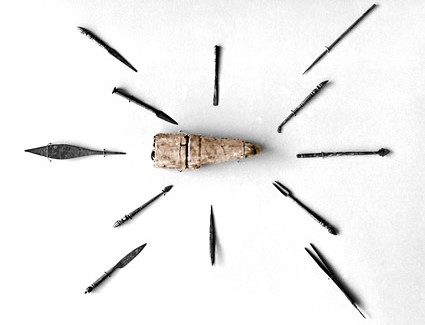
16th Century General Purpose Portable Surgical Kit, From the Wellcome Collection
What a "pocket kit" for a surgeon was during the golden age of piracy does not appear to be very exact. Unlike the plaster box, it isn't described in any detail during this period. It doesn't help that the term 'pocket kit' is rather vague and could be used to refer to a number of different types of instrument sets and their case.
We have already seen an example of a set of dental pelicans housed in what could be called a pocket kit. (Provided one had conveniently large pockets.) There are also a number of drawings in texts and images from period which show portable kits that could be readily referred to as pocket kits although they are very different from the plaster boxes discussed before now.
Based on what is known about them, pocket kits will be divided into two categories in this section: general purpose or 'first aid' kits containing a variety of instruments and task specific kits such as the lancet kits and the dental pelican set seen previously.
Portable Instrument Kits: General Purpose Pocket Kits
The curiously designed sixteenth century kits discussed previously may have been considered pocket kits by their owners.
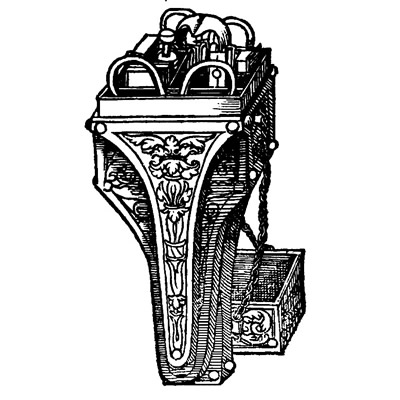
Portable Surgeon's Kit, From Gross Chirurgie, By Walther Hermann Ryff (1562)
The Worshipful Company of Barbers small instrument set is approximately seven inches long by two and three eighths inches across and two inches high. Period patterns show that waistcoat pockets (a very likely place for a surgeon to put a pocket kit) were eight to ten inches long and about three and half to five inches deep.1 All things being equal, the 16th century kits would have fit in pockets.
The plaster box style kits are a likely candidate for early general purpose pocket sets. As mentioned, some of cases that looked like plaster boxes did not have a drawer, which is where Randle Holme said the plasters were stored. These 'drawerless' boxes may have been considered pocket kits. It is also possible that the term 'pocket kit' may may simply have been another word used to describe plaster box whether it had a drawer or not.
Two historians who discuss surgical tools from this period do refer to plaster boxes as pocket kit. John Kirkup explains, "By the seventeenth century silver was more evident [in the makeup of the instrument kit boxes], particularly in small pocket sets… One complete example has a fish-skin case decorated with silver mounts"2. Kirkup includes an image of this case in his book which looks very similar to the one pictured below, although the photo was taken from the top and it is impossible to say whether it has a drawer or not.
Elizabeth Bennion gives an even fuller description in her book:
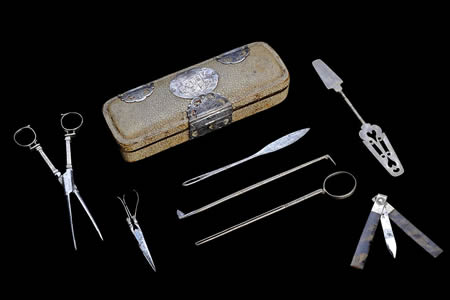
Drawerless Plaster Box Style General Purpose Instrument Kit With Instruments. Includes
(left) Forceps, Scissors, (middle) Seton Needle, Double-Ended Fleam, Speculum Oculi,
(right) Spatula5 and Folding Lancet. From the Wellcome Collection.
Pocket cases opening flat in two halves were made in wood at the same period [17th century]. There is a brass instrument case in the Victoria and Albert Museum, though shagreen seems to have been the most favoured material for these small cases throughout the seventeenth century, the boxes being about 12 to 15 cm [4.75 – 6”] long with rounded ends. Another particularly interesting example, apparently from 1672... This has a drawer in the base, presumably to hold the sharper instruments more safely. A similar one is in the possession of the Wellcome Collection3
What Bennion calls pocket kits are clearly what some period surgeons identify as plaster boxes, with her specifically including one with a drawer. A plaster box (7" x 2-3/8" x 2") would have fit fairly well in period waistcoat pockets (10"-12" x 3.5"x5"), further suggesting that plaster boxes and pocket kits could have been the same thing. However, it is also worth recalling that surgical author Gabriel Le Clerc recommended that a surgeon keep both a plaster box and a pocket kit4, indicating that he felt they were different containers.
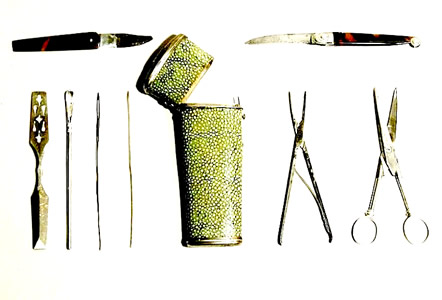
Photo: © Dr. Robert Greenspan, Used with Permission
Shagreen Pocket Surgeon's Kit, From CollectMedicalAntiques.com (18th c.)
Kit Contains: (top) A Folding Fleam, Folding
Incision Knife, (bottom) Spatula5,
Uvula Spoon, Probe with Eye5, Probe (Box), Spring Forceps and Scissors
At some point around this period, clever little portable instrument sets encased in rounded containers about the size of mid-20th century cigarette lighters appeared. These were about two to four inches tall and were sometimes called etuis or 'etwees'. It is not clear when (or even necessarily if) the type of etui seen at left became popular among surgeons. Etuis gained wide popularity in the mid 18th century, being used to contain engineering tools, sewing supplies, gentlemen's and ladies personal care items among other things.
University of Wolverhampton professors Nancy Cox and Karin Dannehl state that 'etwees' were "Originally a CASE for surgical instruments", the earliest reference to which is from 1611.6 It is likely that the etui of the early 15th century referred to the interesting-looking case in the image seen at the beginning of this section. Examples of the little 'cigarette lighter' style can be found on auction sites, in collections and museums, usually dating to the mid-eighteenth century. Such designs may have been around during the early 18th century, although no examples of this have come to my attention. Based on the rarity of small etui-style pocket kits like the one pictured above are less common than task specific lancet kits.
Many of the sea surgeon authors recommended that the surgeon should have a pocket kit handy. John Moyle advised his readers that "your pocket Instruments must be carried every Morning to the Mast between Decks, where our Mortar is usually rung, that such as have any Sore or Ailment may hear in any part of the Ship, and come thither to be drest."7 When preparing for casualties from battle, John Atkins ordered his readers to lay out "your Pocket Instruments, and such light Preparations [medicines and dressings] as are of immediate Call"8. Author Tobias Smollett,
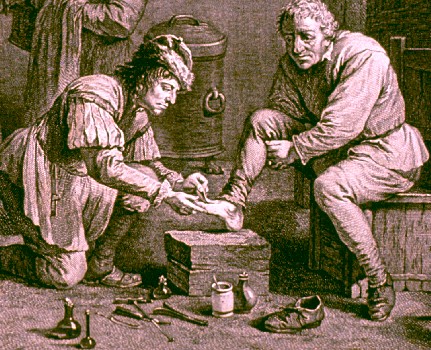
Artist: David Teniers
A Surgeon Operating on a Man's Foot, Pocket Kit Contents in Front of Him,
Le Chirurgien de Capagne (1747)
himself a former sea surgeon, wrote in his fictional tale of a surgeon going to sea that his main character went out into the world after training, with his "whole fortune consisting of one suit of clothes, half a dozen of ruffled shirts, as many plain, two pair of worsted, and a like number of thread stockings, a case of pocket instruments, a small edition of [Roman poet] Horace, [military surgeon Richard] Wiseman's Surgery, and ten guineas in cash"9.
Some sea surgeons also mention other packages of instruments that were likely kept in their pocket. Although John Woodall does not actually use the term 'pocket kit', he mentions a 'bundle of small instruments' from Germany as mentioned previously. He explains that this kit was useful when there is
a heare [hair] or a mote in the eye, a stone in the eare or nostrils, a pin or a bone in the throat, a spill [splinter] in the finger, and divers like casualties [which] unfortunately happen on the sodaine, it is very necessary for the Surgeon to be furnished with such like needful instruments, as are commonly conteyned in the Bundle mentioned10
The listed contents of Woodall's plaster box are notably different than this 'bundle', so his German kit was definitely something different from his plaster box. How Woodall's German instruments were housed is anyone's guess. They sound as if they were wrapped in something, possibly leather or fabric, although Woodall never actually says this.
Sea surgeon Lionel Wafer mentions a similarly bundled kit in his account of the buccaneers journey across the Isthmus of Darien (Panama). "I preserv’d a Box of Instruments [either a pocket kit or a plaster box], and a few Medicaments wrapt up in an Oil Cloth, by having them in my Pocket, where I generally carried them."11 The fact that he specifies both a box of instruments and medicines suggests that the box may not have contained plasters. Since his story took place in the spring of 1681, when plaster boxes were still widely used, it could easily have been a drawerless plaster box.
1 Message discussion with tailor, reenactor and researcher Michael Bagley, 12/24/16; 2 John Kirkup, The Evolution of Surgical Instruments; An Illustrated History from Ancient Time to the Twentieth Century, 2005, p. 97; 3 Elizabeth Bennion, Antique Medical Instruments, 1979, p. 276-7; 4 See Charles Gabriel Le Clerc, The Compleat Surgeon, 1701, p. 5-6; 5 Thanks to Alex Peck for pointing out that I had incorrectly identified the Spatula as a Speculum Lingua and the Probe with Eye as a Seton Needle. Alex explained: "The spatula has a beveled blade, while the tongue depressor is a loop in the 16th century. The spatula is the more important instrument, just look at the Henry VIII compendium case…fleams on one side (barbers) and a spatula on the other (surgeons). The confusion on these use goes wayback, at least to [Elizabeth] Bennion." and "Blood is slick; the eye and thread affords a means to control a probe at the proximal end by finger tips, thus not widening a wound and allowing a deeper penetration, and to remove a probe if lost in a wound. ...A seton is a much more substantial instrument, has a sharp, spear-shaped point; a ribbon was use and placed in a slot diagonal to the blade." 6 Nancy Cox and Karin Dannehl, "Dictionary of Traded Goods and Commodities 1550-1820," british-history.ac.uk, gathered 11/15/16; 7 John Moyle, Chirugius Marinus: Or, The Sea Chirurgeon, 1693, p. 46; 8 John Atkins, The Navy Surgeon, 1742, p. 148; 9 Tobias Smollett, The Adventures of Roderick Random, p. 40; 10 John Woodall, the surgions mate, 1617, p. 17; 11 Lionel Wafer, A New Voyage and Description of the Isthmus of America, 1903, p. 55
Portable Instrument Kits: General Purpose Pocket Kit Instruments
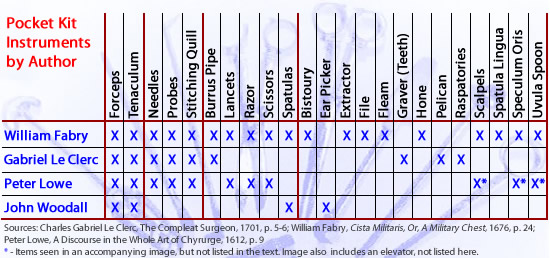
Surgical authors from this period list a wide variety of instruments that they included in their pocket kits. There are twenty-three different instruments to be found in the descriptions given by four different authors.
German surgeon William Fabry includes the greatest number of instruments in his kit at twenty. Sea surgeon John Woodall names the fewest instruments at four, although Woodall does state that the set he is referring to actually includes twenty total instruments, putting it more in line with the quantity of instruments found in Fabry's pocket kit.1 However, because he only listed the four instruments, nothing more can be said about what was included in his set. French surgeon Gabriel Le Clerc lists nine instruments and English surgeon Peter Lowe lists eight. Lowe also includes an image of his pocket kit (seen on the first page of this article) which show four instruments he does not list. So there may have been twelve instruments in his pocket kit.
The chart seen above left shows all the instruments, listed in order by the number of times each instrument is included by the four authors. The red vertical lines divide those instruments mentioned by four authors from those included by three and so on. Like the plaster box, some of the more versatile instruments are widely supported such as forceps and probes. 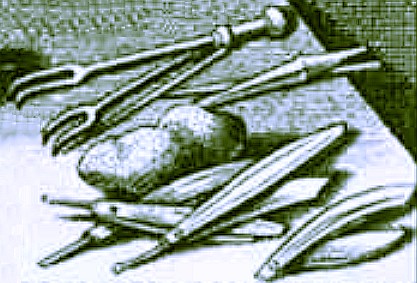
Hooks, Sponge, Folding Knives and Probes, From The Workes of That
Famous
Chirurgeon Ambrose Parey, Frontispiece, (1649)
Unlike the plaster box, scissors and spatulas are mentioned by only half of the authors as being included in pocket kits. Suturing equipment (needles and the stitching quill) are widely included as they were in the plaster box. Somewhat surprisingly, lancets are only included by half the authors. Gabriel Le Clerc doesn't mention them being in his pocket kit, although he does say they are among the instruments in his plaster box. Curiously, Le Clerc call the pocket kit a "Lancet-Case with his Plaister-Box"2, which sounds as if it were a task specific pocket kit for lancets. However, even though lancets aren't actually included in Le Clerc's list of pocket kit instruments, he later mentions they are kept in these "very neat Lancet-Cases"3!
Thirteen of the twenty three instruments are mentioned by only a single author. Not surprisingly, Fabry's large twenty instrument pocket kit contains nine of the thirteen tools that are only mentioned by one author.
The large number of single-mention tools may be due to the fact that many of them are meant for specific operations. These include the ear picker, file, graver, pelican, raspatory, speculum oris and uvula spoon. As with the instruments found in the plaster box, the incision and crooked knives again get the cold shoulder, again suggesting limited use for cutting the skin in first aid situations. The extractor and fleam would seem to be useful in a variety of situations, but they are also only listed by one author.
1 John Woodall, the surgions mate, 1617, p. 17-8; 2,3 Charles Gabriel Le Clerc, The Compleat Surgeon, 1701, p. 5
Portable Instrument Kits: Task Specific
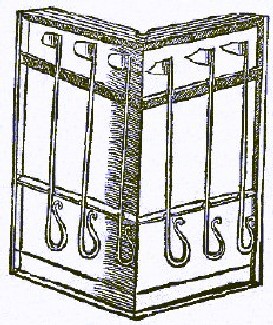
Pocket Fleam Set, From Gross Chirurgie, Vol. 1,
By Walther Hermann Ryff (1562)
In addition to the general purpose instrument kits there were a variety of task specific instrument kits containing instruments suited to a particular operation. Most of these either contained sets of flames or folding lancets. Two different sixteenth century drawings of pocket kits show fleams as seen here.
What these two pocket kits are made of is not entirely clear. They actually look like books, possibly having had the pages cut out to house the fleams. If this is the case, it is not clear why a surgeon would want to embed his case of fleams in a book. They may also have been made of some other material which is not obvious from these woodcuts. The one found in Walther Hermann Ryff's book (at right) has more of purpose-designed appearance than the one from Johannes Charetanus' book (below left), possibly being made from wood or leather, although this is only speculation. What is clear from these images is that these pocket fleam kits folded shut. The Charetanus kit has a clasp to secure it when closed, although no clasp is shown in Ryff's drawing.
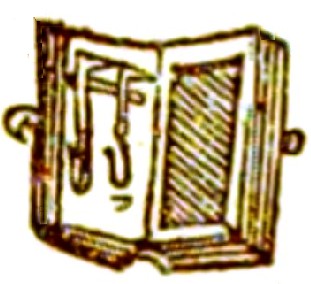
Pocket Fleams, From Wundartzney zu allen gebrechen des
gantzen Leibs, By Johannes Charetanus (1531)
By the seventeenth century, the pocket kits were likely designed like the plaster box, possibly without a drawer, as discussed in the previous section. Although no obvious drawings or examples of task specific instrument cases appear from this time, they are mentioned in the surgical books. Miliary surgeon Thomas Brugas writes that, "Of Lancets, the Artist is to have always a Case of good ones in his Pocket."1 Henry Shaw's will mentions "One Case with Six Lanchetts"2. This was mentioned separately from his silver plaster box.
Surgeon James Cooke advises that a "Chirurgion had need to have 2. cases of Lancets, and each case [contains] six"3. Cooke adds that "Its very requisite a hone and whet-stone should be kept to set [sharpen] your lancets, incision knives and rasours upon."4 He does not mention these items as being included in his plaster box instruments, nor is it clear if they are actually placed in the lancet kit. If the lancet pocket kits were like the plaster box, there would certainly have been room for them, but it's not possible to say if they are in the case from this description.
Lancets themselves underwent evolution to make them more portable some time before the golden age of piracy. Military surgeon and historian John Kirkup explains that straight lancet blades with sheaths and scabbards were gradually replaced by lancets with a "knife that
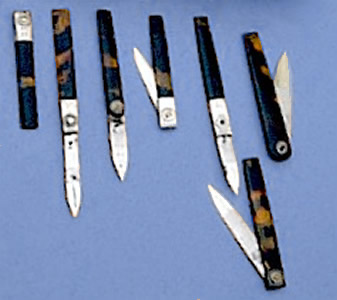
Photo: Dan Underhill - Various Tortoise Shell Handled Lancets
folded into an integral handle provided protection for the blade point and permitted knives to be carried safely in a coat pocket."5 Kirkup goes on to say that,
Kirkup elsewhere explains, "Thumb lancets, which were developed in the sixteenth century, had wafer-thin blades protected with horn, or more often, tortoiseshell handles, also known as leaves, that folded back when the blade was applied for bleeding."7 While he doesn't comment on lancet pocket cases in particular, Kirkup does say that such instruments would take up less space "in his pocket or minor instrument case, a significant advantage"8.During the later sixteenth century in Europe simple wooden and horn handles were replaced by exotic materials, and tortoiseshell in particular was utilized for folding handles. Initially, such knives and scalpels were constructed with a simple ‘stop position’ when fully opened, the proximal butt of the blade being shaped to impinge against the two tortoiseshell leaves of the handle.6
The eighteenth century saw a boom in the etui-style cases, which includes a large number of extant etuis containing lancets. Historian Guy Williams says that "small pocket lancets taken by eighteenth-century physicians on their rounds were often carried in attractive cases made of silver, shagreen, tortoiseshell, or some other relatively expensive material."9 Medical instrument historian Elisabeth Bennion notes that "Silver cases of the etui-type for lancets and, occasionally, other instruments, date from the early eighteenth century."10 A number of examples of 18th century etui-style lancet cases appear during the mid eighteenth century, such as those seen below.
|
Photo:Mission Shagreen Lancet Etui (mid 18th c.) |
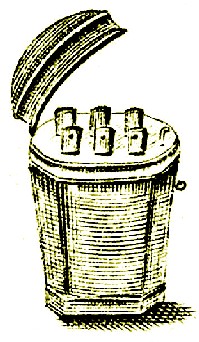 Lancet Etui From Cutler Robert Sparling's Trade Card (1762) |
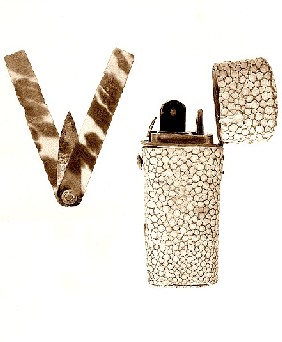 Lancet Etui Pocket Kit and Tortoise Shell Fleam From the Wellcome Collection (18th c.) |
1 Thomas Brugis, Vade Mecum, 1689, p. 206; 2 Familyrecords.dur.ac.uk, gathered 11/19/16; ,3,4 James Cooke, Supplementum chirurgiae and the Military Chest, 1655, p. 422; 5,6 John Kirkup, The Evolution of Surgical Instruments; An Illustrated History from Ancient Time to the Twentieth Century, 2005, p. 194; 7 Kirkup, p. 154; 8 Kirkup, p. 194; 9 Guy Williams, The Age of Agony, p. 14-5; 10 Elizabeth Bennion, Antique Medical Instruments, 1979, p. 156

